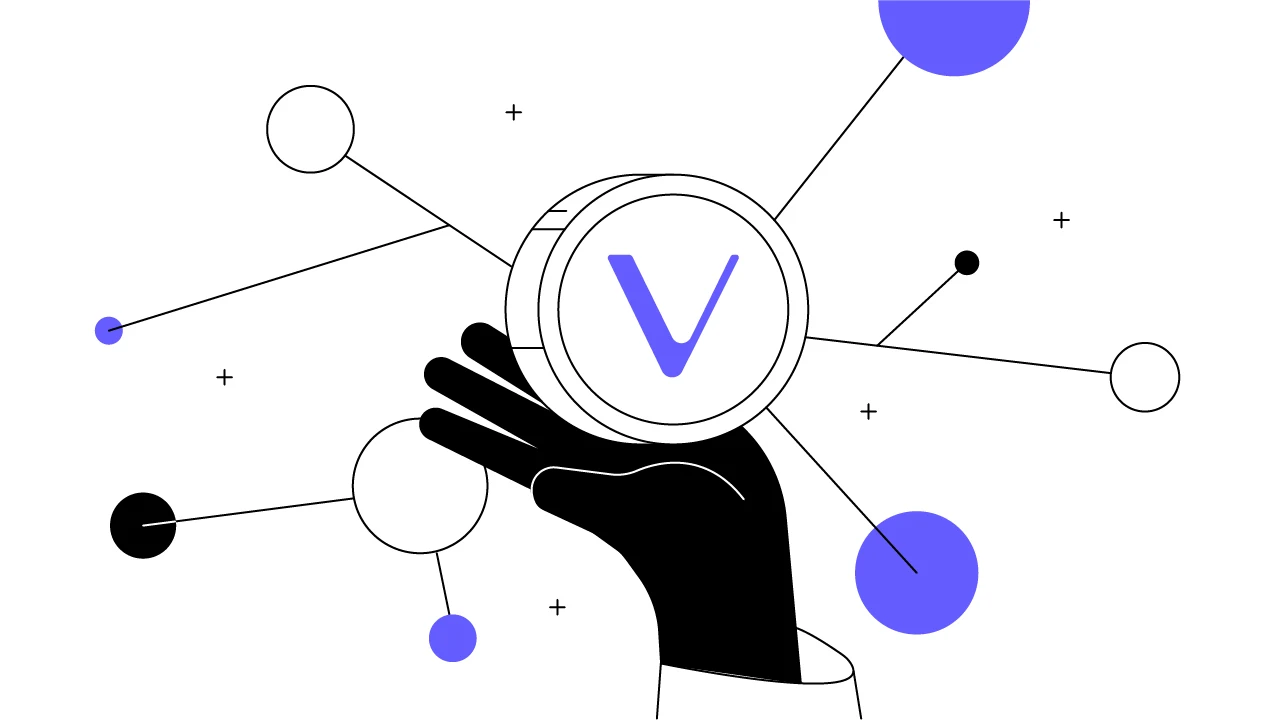Contents
VeChain (VET): Understanding VeChain’s Governance Structure
The flexibility and adaptability built into VeChain’s governance structure are critical for the success of any blockchain project, which is why it’s an important paradigm for others.
Updated October 21, 2021 • 3 min read

Summary
VeChain’s governance system is geared toward transparency, trust, and operational efficiency. The VeChain Foundation oversees the entirety of the project and is made up of various constituents that ensure VeChain’s governance system runs smoothly.
To build a decentralized public blockchain network that is scalable and adheres to the types of rigourous frameworks that governments, regulators, and large enterprises around the world require, VeChain is able to change and improve its governance structure as the project expands to work with a wider range of global stakeholders. The VeChain project does this by valuing autonomy and pursuing self-governance through a democratic and balanced structure.
Main Components of VeChain’s Governance Model
The governance model for the VeChain ecosystem will be discussed in greater detail below. The ecosystem’s main entities are structured as follows:
Stakeholders with voting authority (via Authority Masternodes, Economic X Nodes, and Economic Nodes)
VeChain Foundation’s Board of the Steering Committee
VeChain Advisory Board
VeChain Improvement Proposals (VIP’s)
Five different functional committees:
Technical Committee (R&D and Technical Support Units)
Operational Committee (Finance, Human Resources, and Administrative Units)
Regulation Committee (Legal and Compliance Unit)
Compensation and Nomination Committee
Public Relations Committee (Marketing, Public Relations, and Business Collaboration Units)
The VeChain Blockchain’s Steering Committee Board
The Steering Committee Board is the VeChain Foundation’s most important governing body. The board is selected by stakeholders with voting authority (via different types of nodes) and is made up of VeChain Foundation members, Authority Masternode holders, developers, business partners, and independent members. The board’s main functions are to:
Examine, approve, and monitor the VeChain Foundation’s most important technical, financial, strategic, and business-related activities.
Propose and arrange stakeholder voting events to discuss fundamental issues surrounding the development of the VeChainThor blockchain and the VeChain ecosystem.
Review, monitor, approve, and modify the main principles of the VeChain Foundation.
Give strategic guidance based on regular reporting from the foundational committees.
Review, monitor, approve, and modify the VeChain Foundation’s annual budget, financial status, holdings of the VET cryptocurrency, revenue use, and major transactions.
Perform on-chain governance operations to guarantee that proper decision-making is carried out.
Review, monitor, approve, and modify the electoral structure of Steering Committee members, functional committee chairs, and the General Secretary of the VeChain Foundation.
Review, monitor, approve, and modify the operational costs of the VeChainThor blockchain using VTHO and VET coins.
The Steering Committee helps determine overall project strategy, and selects functional committee chairs to oversee the five main committees of the VeChain Foundation. The board also regularly receives external input from the VeChain advisory board. Every two years, the main members of the Steering Committee Board are re-elected. The board meets at least four times per year to discuss the current direction and strategy of the VeChain project. Topics of discussion include proposed changes for funding, project development, business strategy, blockchain construction, and VeChain adoption.
VeChainThor Network Node Allocation and Stakeholder Structure
Stakeholders with voting authority are made up of three different node groups that are required to possess a specific amount of VET coins to help maintain the integrity of the VeChainThor blockchain. Stakeholders can be large corporations, government agencies, individuals, non-profit organizations, and other bodies that hold a stake in the VeChain project. VeChain’s node-based voting structure includes:
Authority Masternodes (AM): 25,000,000 minimum VET — 1 AM vote
Four tiers of Economic X Nodes (XN):
MX: 15,600,000 minimum VET — 26 XN votes
TX: 5,600,000 minimum VET — 10 XN votes
SX: 1,600,000 minimum VET — 3 XN votes
VX: 600,000 minimum VET — 1 XN vote
Three tiers of Economic Nodes (EN)
M: 15,000,000 minimum VET — 15 EN votes
T: 5,000,0000 minimum VET — 5 EN votes
S: 1,000,000 minimum VET — 1 EN vote
Authority Masternodes have the most overall voting power (40%), even though Economic X Nodes (XN’s) also hold 40% voting power. In December of 2019, when the second full version of the VeChainThor whitepaper was published, there were 101 Authority Masternodes in existence. Authority Masternodes are extremely difficult to obtain, and require full Know-Your-Customer (KYC) verification through the VeChain Foundation, and often need a direct affiliation with VeChain. Given this overall tiered structure, the project can be described as semi-centralized — incorporating both centralized and decentralized aspects into its governance system.
The VeChainThor blockchain utilizes a Proof-of-Authority (PoA) consensus mechanism, leveraging Authority Masternodes to maintain network balance. Each transaction on the network is validated through AMs. Authority Masternodes are network-connected servers that keep a complete copy of the blockchain. They are needed not only for on-chain pre-approval of entities that can interact with VeChainThor, but also to produce blocks on the VeChainThor blockchain. As stated above, Economic X Nodes (XN’s) have 40% voting power, and are split into four different tiers, while Economic Nodes (ENs) have 20% of the voting power and are divided into three different tiers.
Based on the amount of VET collateralized, each main node type is given a specific and proportional number of votes that can be used to impact the overall strategic direction of the VeChain project.
Functional Committees and VeChain Improvement Proposals (VIPs)
As noted above, there are five major committees that operate with the guidance of the Steering Committee Board, the VeChain Advisory Board, and different stakeholders with voting authority. For each committee, a chair is appointed to run the specific operational unit of the VeChain Foundation. The five functional committees are:
Technical Committee
Operational Committee
Regulation Committee
Compensation and Nomination Committee
Public Relations Committee
To address specific fundamental challenges within the VeChain Foundation, voting is required by committee members. Important topics that can be voted upon include:
The electoral process to determine the new Steering Committee Board
Drastic fundamental changes to the consensus mechanism of the VeChainThor blockchain excluding regular enhancements or updates
Changes to the speed at which VTHO coins are generated. VTHO coins are used to power transactions on the VeChain network, and are equal to the cost of transacting on the network
Additional subjects that the Steering Committee Board deem appropriate for stakeholder voting processes
Furthermore, one of the most important features that helps maintain the integrity of the VeChain ecosystem is the implementation of VeChain Improvement Proposals (VIP’s). VIP’s are used by the VeChain development team, the VeChain Foundation, and global community members to propose upgrades for different aspects of the VeChainThor Blockchain and VeChain ecosystem. The four types of VIP’s are:
Core: improvements requiring a consensus fork.
Application: changes to application-level standards and conventions, including contract standards.
Interface: improvements around client API specifications and standards, and certain language-level standards like method names and contract Application Binary Interfaces (ABI’s).
Information: descriptions of a design issue, as well as provision of general guidelines or information to the community, but not proposals of new features.
A Foundational Model for the Governance of Blockchain
VeChain’s governance structure is a strong model for other blockchain projects in the industry. With its simplified usability yet sophisticated structure, the VeChain Foundation is able to maintain the integrity, transparency, and innovation needed to ensure that the VeChainThor blockchain and the VeChain ecosystem continue to operate in a way that is balanced and adaptable to changing circumstances. This flexibility is pivotal to the long-term success of VeChain, particularly because the project is constantly changing, improving, and restructuring its business model. Such forms of adaptation are critical in light of changing global market conditions, evolving business partnerships, and various other factors.
Cryptopedia does not guarantee the reliability of the Site content and shall not be held liable for any errors, omissions, or inaccuracies. The opinions and views expressed in any Cryptopedia article are solely those of the author(s) and do not reflect the opinions of Gemini or its management. The information provided on the Site is for informational purposes only, and it does not constitute an endorsement of any of the products and services discussed or investment, financial, or trading advice. A qualified professional should be consulted prior to making financial decisions. Please visit our Cryptopedia Site Policy to learn more.

Is this article helpful?


